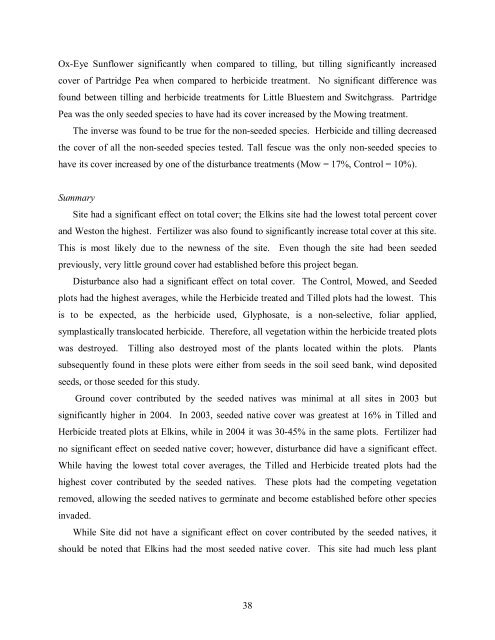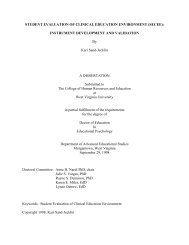The Use of Native Plants for Revegetation along West Virginia ...
The Use of Native Plants for Revegetation along West Virginia ...
The Use of Native Plants for Revegetation along West Virginia ...
Create successful ePaper yourself
Turn your PDF publications into a flip-book with our unique Google optimized e-Paper software.
Ox-Eye Sunflower significantly when compared to tilling, but tilling significantly increased<br />
cover <strong>of</strong> Partridge Pea when compared to herbicide treatment. No significant difference was<br />
found between tilling and herbicide treatments <strong>for</strong> Little Bluestem and Switchgrass. Partridge<br />
Pea was the only seeded species to have had its cover increased by the Mowing treatment.<br />
<strong>The</strong> inverse was found to be true <strong>for</strong> the non-seeded species. Herbicide and tilling decreased<br />
the cover <strong>of</strong> all the non-seeded species tested. Tall fescue was the only non-seeded species to<br />
have its cover increased by one <strong>of</strong> the disturbance treatments (Mow = 17%, Control = 10%).<br />
Summary<br />
Site had a significant effect on total cover; the Elkins site had the lowest total percent cover<br />
and <strong>West</strong>on the highest. Fertilizer was also found to significantly increase total cover at this site.<br />
This is most likely due to the newness <strong>of</strong> the site. Even though the site had been seeded<br />
previously, very little ground cover had established be<strong>for</strong>e this project began.<br />
Disturbance also had a significant effect on total cover. <strong>The</strong> Control, Mowed, and Seeded<br />
plots had the highest averages, while the Herbicide treated and Tilled plots had the lowest. This<br />
is to be expected, as the herbicide used, Glyphosate, is a non-selective, foliar applied,<br />
symplastically translocated herbicide. <strong>The</strong>re<strong>for</strong>e, all vegetation within the herbicide treated plots<br />
was destroyed. Tilling also destroyed most <strong>of</strong> the plants located within the plots. <strong>Plants</strong><br />
subsequently found in these plots were either from seeds in the soil seed bank, wind deposited<br />
seeds, or those seeded <strong>for</strong> this study.<br />
Ground cover contributed by the seeded natives was minimal at all sites in 2003 but<br />
significantly higher in 2004. In 2003, seeded native cover was greatest at 16% in Tilled and<br />
Herbicide treated plots at Elkins, while in 2004 it was 30-45% in the same plots. Fertilizer had<br />
no significant effect on seeded native cover; however, disturbance did have a significant effect.<br />
While having the lowest total cover averages, the Tilled and Herbicide treated plots had the<br />
highest cover contributed by the seeded natives. <strong>The</strong>se plots had the competing vegetation<br />
removed, allowing the seeded natives to germinate and become established be<strong>for</strong>e other species<br />
invaded.<br />
While Site did not have a significant effect on cover contributed by the seeded natives, it<br />
should be noted that Elkins had the most seeded native cover. This site had much less plant<br />
38












